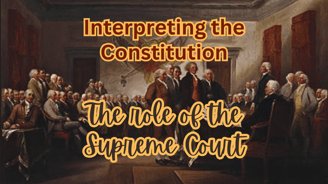The role of the Supreme Court in interpreting the Constitution.
The United States Supreme Court, established by the Constitution in 1789, plays a crucial role in interpreting the nation's founding document. This article aims to clarify the Court's function, its power of judicial review, and the ongoing debates surrounding its role in American governance.
9/7/20233 min read


Establishment and Judicial Review:
The Constitution established the Supreme Court but did not explicitly grant it the power of judicial review.
This authority - to examine and potentially invalidate actions of other government branches - was asserted by the Court itself in the landmark 1803 case Marbury v. Madison.
Chief Justice John Marshall's opinion in this case laid the foundation for the Court's power to interpret the Constitution and strike down laws it deems unconstitutional.
Controversy Surrounding Judicial Review:
The power of judicial review has been a subject of debate since its inception:
Critics argue that it gives unelected judges too much power, potentially allowing them to legislate from the bench.
Supporters contend it's a necessary check on the other branches of government, preventing overreach and protecting individual rights.
The debate often centers on whether the Court should strictly interpret the Constitution based on its original meaning or view it as a "living document" adaptable to changing times.
Constitutional Interpretation Methods:
The Court employs various methods to interpret the Constitution:
Textualism: Focusing on the literal meaning of the Constitution's words.
Originalism: Interpreting the Constitution based on its original meaning and the framers' intent.
Living Constitution: Viewing the Constitution as adaptable to contemporary circumstances.
Precedent (Stare Decisis): Relying on previous Court decisions to guide current interpretations.
Limitations on the Court's Power:
While the Supreme Court's role is crucial, it's important to understand its limitations:
The Court can only rule on cases brought before it; it cannot proactively create laws or policies.
Its decisions can be overturned by constitutional amendments, though this is a rare and difficult process.
The Court relies on the executive branch to enforce its decisions and on public acceptance for legitimacy.
Justices are appointed by the President and confirmed by the Senate, tying the Court to the political process.
Historical Impact and Landmark Decisions:
The Court's interpretations have significantly shaped American society. Some pivotal cases include:
Brown v. Board of Education (1954): Outlawed racial segregation in public schools.
Roe v. Wade (1973): Established a constitutional right to abortion (later overturned).
Obergefell v. Hodges (2015): Legalized same-sex marriage nationwide.
These decisions demonstrate the Court's power to effect sweeping societal changes through constitutional interpretation.
Ongoing Debates and Criticisms:
Several issues continue to fuel debate about the Court's role:
Judicial Activism vs. Judicial Restraint: Should the Court proactively address societal issues or defer to elected branches?
Politicization: Concerns about the Court becoming increasingly partisan and ideologically driven.
Lifetime Appointments: Debates over whether justices should serve limited terms instead.
Court Packing: Controversies surrounding proposals to increase the number of justices.
Conclusion:
The Supreme Court's role in interpreting the Constitution is fundamental to the American system of government, yet remains a source of ongoing debate for some reason, even though this subject has been gone over a thousand times.
Democratic thinking would prefer a living constitution, one that flows with the way of life. If we go this route I believe tyranny will set in and around and around we go with this.
As Jefferson said long ago, we must follow the Constitution in the way it was meant in order to safeguard our freedoms
While the Court serves as a crucial check on governmental power and protector of individual rights, questions persist about the extent of its authority and the best methods for constitutional interpretation.
As American society evolves, the dialogue surrounding the Court's role in shaping the nation's legal landscape continues to be a vital aspect of our constitutional republic.
References:
Amar, Akhil Reed. (2012). "America's Unwritten Constitution: The Precedents and Principles We Live By." Basic Books.
Tushnet, Mark V. (2009). "I Dissent: Great Opposing Opinions in Landmark Supreme Court Cases." Beacon Press.
Ely, James W. Jr. (2008). "Democracy and Distrust: A Theory of Judicial Review." Harvard University Press.
Irons, Peter H. (2006). "A People's History of the Supreme Court: The Men and Women Whose Cases and Decisions Have Shaped Our Constitution." Penguin Books.





